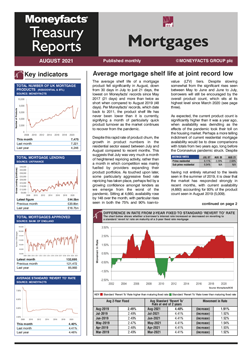Eleanor Williams, Finance Expert at Moneyfacts, said:
“Product numbers in the residential mortgage sector have dropped for the first time since October 2020, reducing by 38 to 5,356. Such a small month-on-month reduction in numbers, rather than a cause for concern, could potentially be a sign of the market returning to a level of stability after a tumultuous couple of years. There are in fact 280 more deals than were on offer in February 2020 before the onset of the pandemic.
“While fixed rate mortgage pricing is not intrinsically linked to changes in the Bank of England base rate, prior to the decision to double base rate to 0.50% last week, we had recorded increases of 0.06% and 0.05% to the average overall two– and five-year fixed rates between January and February. At 2.44% and 2.71% respectively, following four months of consecutive rises, these rates are the highest they have been since August 2021 (2.52% and 2.75%). The 60% LTV tier saw the largest monthly rises, with the two- and five-year averages going up by 0.09% and 0.08% to 1.82% and 2.06% respectively. In fact, since October the lower LTV average rates have far outpaced the overall average rate increases as providers seem to have made their most competitive pricing decisions in the top LTV brackets of late.
“Prospective new mortgage customers may see that the average shelf life of a mortgage product rose from 28 days to 42 days in February, which meant that those looking to secure a new mortgage before potential further rate rises had more time to choose a product. This could suggest that lenders had already made many of their re-pricing decisions in anticipation of the base rate rise in December 2020 and therefore January saw fewer updates made. However, conversely, this lull in activity could be a reflection of lenders holding back on re-pricing decisions in advance of last week’s move, and so it may be a different story next month.
“February also saw the average SVR rate increase by 0.05% to 4.46%, so those sitting on their lenders’ revert rate may wish to move swiftly to secure a new fixed deal to protect themselves from potential further increases. As the cost of living continues to spiral for consumers, those in a position to consider a new mortgage deal may wish to seek advice sooner rather than later.”
Eleanor Williams, Finance Expert at Moneyfacts, said:
“Product numbers in the residential mortgage sector have dropped for the first time since October 2020, reducing by 38 to 5,356. Such a small month-on-month reduction in numbers, rather than a cause for concern, could potentially be a sign of the market returning to a level of stability after a tumultuous couple of years. There are in fact 280 more deals than were on offer in February 2020 before the onset of the pandemic.
“While fixed rate mortgage pricing is not intrinsically linked to changes in the Bank of England base rate, prior to the decision to double base rate to 0.50% last week, we had recorded increases of 0.06% and 0.05% to the average overall two– and five-year fixed rates between January and February. At 2.44% and 2.71% respectively, following four months of consecutive rises, these rates are the highest they have been since August 2021 (2.52% and 2.75%). The 60% LTV tier saw the largest monthly rises, with the two- and five-year averages going up by 0.09% and 0.08% to 1.82% and 2.06% respectively. In fact, since October the lower LTV average rates have far outpaced the overall average rate increases as providers seem to have made their most competitive pricing decisions in the top LTV brackets of late.
“Prospective new mortgage customers may see that the average shelf life of a mortgage product rose from 28 days to 42 days in February, which meant that those looking to secure a new mortgage before potential further rate rises had more time to choose a product. This could suggest that lenders had already made many of their re-pricing decisions in anticipation of the base rate rise in December 2020 and therefore January saw fewer updates made. However, conversely, this lull in activity could be a reflection of lenders holding back on re-pricing decisions in advance of last week’s move, and so it may be a different story next month.
“February also saw the average SVR rate increase by 0.05% to 4.46%, so those sitting on their lenders’ revert rate may wish to move swiftly to secure a new fixed deal to protect themselves from potential further increases. As the cost of living continues to spiral for consumers, those in a position to consider a new mortgage deal may wish to seek advice sooner rather than later.”










